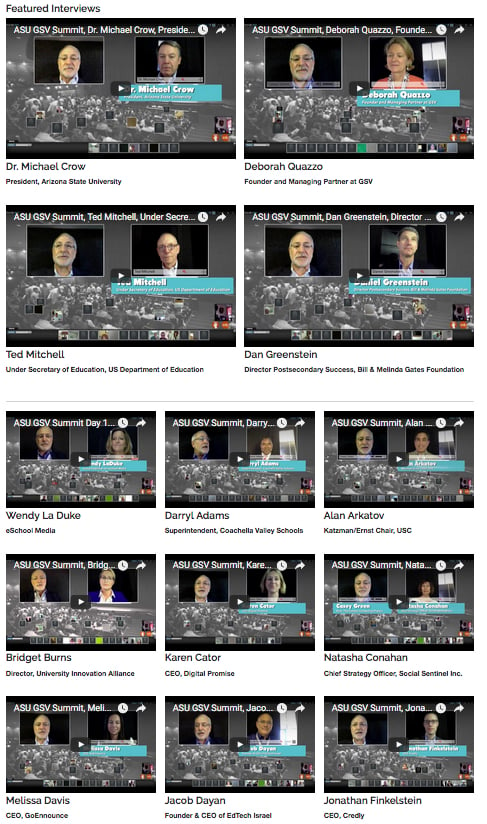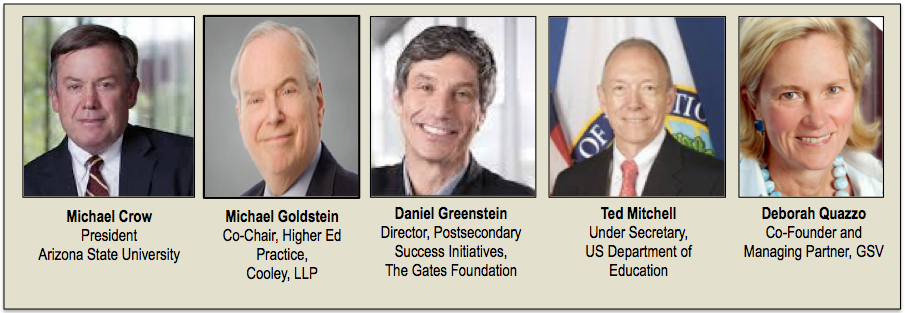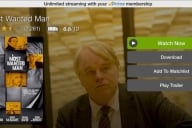You have /5 articles left.
Sign up for a free account or log in.

Two weeks ago some 3,500 educators, education entrepreneurs, investors, and corporate executives, plus officials from government agencies and non-profit organizations, gathered in San Diego for the seventh annual ASU GSV Innovation Summit. As I noted in my Digital Tweed post a few days ahead of the event, the program included “big names in big bold fonts . . . and also many whose names appear in small fonts who are very focused on effective innovation, often framed by a personal experience in K-12 or college classrooms, and fueled by entrepreneurial energy.”
Reporting a few days after the San Diego gathering, Inside Higher Ed’s Doug Lederman described this year’s Summit as “easy to caricature,” and as an event where “technology companies big and small promoted their products and begged for dollars from Silicon Valley and other investors who are pouring money into education right now.” Lederman also noted a shift in the demographics of the conference attendees as the organizers made an effort to include some one thousand K-12 and campus officials, many benefitting from subsidized travel and conference passes. Moreover, some of the K-12 and higher ed participants were invited to the podium so that the conference conversations were less about K-12 and higher ed as seen from corporate and ed entrepreneur perspectives, and more with K-12 and higher ed about opportunities and strategies to address pressing challenges.
Great conference experiences are marked by engaging conversations. I usually think I’m doing well if I have 10-12 useful and informative conversations at a conference. This year at the ASU-GSV Summit, I was fortunate to have some three dozen really engaging and informative conversations because I was locked in a black box for three afternoons interviewing college presidents, the undersecretary of education, foundation officers, campus and K-12 officials, plus ed entrepreneurs and corporate executives – individuals that ed tech skeptics might cast as members of the “education-technology complex.”

Yet the skeptics notwithstanding, for me there was no question that all these individuals shared a common goal: how to enhance the student learning experience, provide more educational opportunities, make better, more informed use of data for decision-making, improve student retention and completion rates, and also improve educational outcomes.
These interviews were part of a collaborative effort with eSchool Media, which publishes eSchool News and eCampus News, and Shindig. The 33 interviews over the three afternoons at the ASU GSV Summit reflected an effort to connect Summit presenters and participants with educators in schools and colleges, via live, interactive interviews or by access to the interview archives.
The full set of interviews, which run about 15-18 minutes each, are now available online. Here are some highlights from five of the more than 30 conversations:

== Ted Mitchell, Under Secretary of Education, acknowledged that the “linear production function in education” – simply pour resources on one or more targeted issues – has been disproved because there are lots of dynamic, moving, and interactive parts that affect efforts at reform, innovation, improving student learning, and enhanced educational outcomes. Mitchell stated that “we’re getting smarter about data” in education. For the Department of Education, the one current data priority is to make more information available and to provide better analytic tools for students and parents to make smarter decisions about the college experience and their college investments. Mitchell also noted that the power of predictive analytics has already shown great potential in higher education, citing the experience of Georgia State University which used a decade of student data to identify interventions that effectively eliminated the retention and degree completion gaps that traditionally separated first generation, low-income, and minority students from their peers. Finally, Mitchell spoke with pride about the education initiatives of the Obama administration, citing as major achievements the new emphasis on educational outcomes, a “laser focus” focus on equity, increasing the number and size of Pell Grants, the transition to the Direct Student Loan Program, and the simplification of the FAFSA form.
== ASU President Michael Crow explained how the transition to a new, student-centric mission enabled his institution to increase enrollment, raise undergraduate retention and graduation rates, improve retention and graduation numbers for low-income and minority students, and register dramatic gains in research funding even as the legislature was cutting state support for ASU and other postsecondary institutions in Arizona. Crow also revealed that the “secret sauce” in the University’s online programs and their “BAs for Starbucks Baristas” initiative is based on one-third content and technology infrastructure and two-thirds support services. Finally, Crow ended our conversation with a compelling statement about accountability: “At the end of the day, it’s all about outcomes. If you are an institution like ASU and you have 40,000 Pell eligible students, [then] we should be asked ‘how are we doing?’ We should be incentivized and [also] held accountable for these investments [and these students]. We’re getting very uneven outcomes based on SES status and family income: half the people who receive Pell grants don't receive any degree or any certificate from any institution. We need to step back and say that’s not way it’s going to be in the future.”
== Daniel Greenstein, director of postsecondary success at the Bill & Melinda Gates Foundation provided an overview of the Foundation’s programmatic and policy initiatives intended to improve postsecondary education, which focus in large part on efforts to improve access, retention, and graduation rates for low-income and minority students. By extension these efforts, explained Greenstein, also help to enhance the nation’s long-term economic development. Greenstein discussed the movement underway in the Foundation’s efforts from campus pilots to institutional projects that will “move at scale,” and the accompanying challenge of sustainability for “student-centered success initiatives.”
== Deborah Quazzo, founder and managing partner of GSV (the conference co-sponsor) described the mission of the ASU GSV Innovation Summit as a unique opportunity to bring together a diverse group of educators, corporate executives, aspiring education entrepreneurs, and foundation officers for engaging and energetic conversations about innovation and improving K-12 and higher ed: “We have anecdotes of people who have transformed their classrooms, their schools, and their lives” based on their experience at the Summit. Quazzo is among those who believe that increasing numbers of students, of all ages, will abandon traditional postsecondary institutions to seek alternative pathways for postsecondary education, training, and labor market certification. And Quazzo closed our conversation by stating “we're getting very close the ability to show efficacy. In five years hopefully every company [at this conference] will able to stand up and say this is my value proposition and this is how we deliver a higher return to education.”
== Michael Goldstein, co-chair of the higher education practice at Cooley LLP who has been cited by Forbes Magazine as one of higher ed’s “top ten influencers,” offered insight to the role of regulation not often heard either on- of off-campus. Goldstein noted that some regulations stimulate and provide incentives for innovation, such as ADA requirements, where there has been great hope for eLearning technologies. Concurrently, he noted that some technology solutions may also present new problems: “all government agencies have a history of coming up with ideas that are about 75 percent thought through; it is the other 25 percent that present the challenge.” Goldstein also discussed the regulatory challenges that the Carnegie Unit poses to new learning models such as competency-based education: “We are measuring the wrong end of the student. We have a regulatory framework [based on seat time as opposed to what and how students learn] that is inconvenient for how we have traditionally disbursed federal financial aid.”
The ASU GSV Summit interviews cover a wide range of topics from a rich array of perspectives. As the interview moderator, and at the risk of shameless self-promotion, I can report that conversations are interesting and informative. I also hope you find them engaging.
Disclosure: The ASU GSV Summit Interview Series was supported, in part. by a grant from the Bill & Melinda Gates Foundation.
Follow me on Twitter: @DigitalTweed






